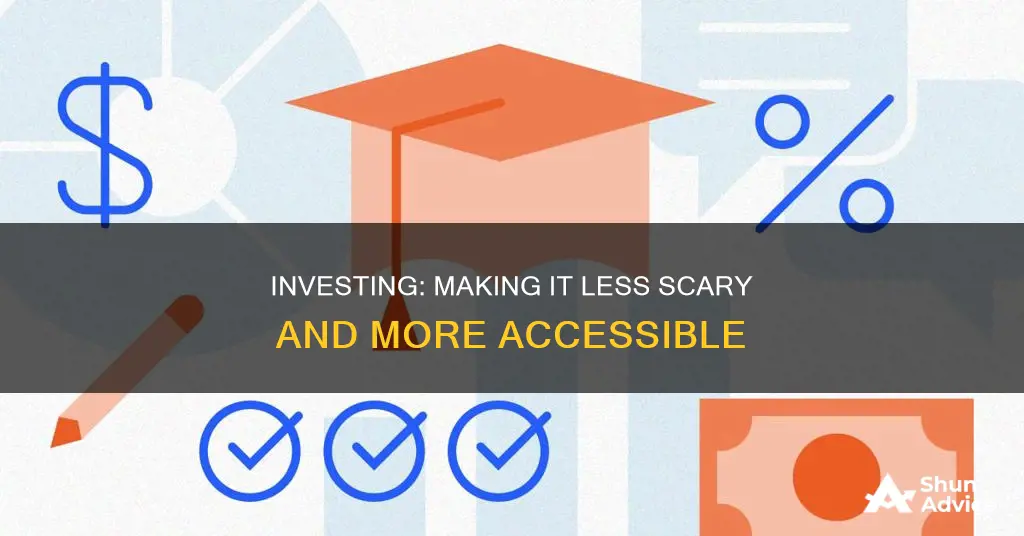
Investing can be scary, but it doesn't have to be. Many people are hesitant to start investing due to a fear of the unknown, losing money, or making mistakes. However, investing is a critical component of financial health and can help individuals build wealth and attain financial freedom. Here are some ways to make investing less scary:
- Educate yourself about investing before jumping in. Read books, watch videos, listen to podcasts, or use trading simulators to learn about different investment options and strategies.
- Start small and invest in something you understand. You don't need to invest a large sum of money right away. Start with a small investment and gradually increase it over time as you become more comfortable.
- Diversify your investments. Don't put all your eggs in one basket. Spread your investments across different assets, such as stocks, bonds, or index funds, to reduce risk.
- Focus on long-term gains rather than short-term profits. Investing is typically a long-term strategy, and it's important to remember that the stock market has ups and downs. Don't panic during downturns, and don't try to time the market.
- Seek professional help. Consider working with a financial advisor or using a digital investment platform that can provide guidance and support based on your risk tolerance and financial goals.
| Characteristics | Values |
|---|---|
| Timeframe | Long-term investing is less scary than short-term investing |
| Risk | Do not invest more than you are comfortable losing |
| Diversification | Do not put all your eggs in one basket; invest in a variety of assets |
| Education | Educate yourself about investing before making a move |
| Goals | Figure out your goals and risk tolerance |
| Comfort zone | Evaluate your comfort zone in taking on risk |
| Financial roadmap | Draw a personal financial roadmap |
| Emergency fund | Put money in a savings product to cover an emergency |
What You'll Learn

Diversify your investments to reduce risk
Diversifying your investments is a great way to reduce the risk associated with investing. Here are some ways to do it:
Understand the Basics of Diversification
Diversification is a risk management strategy that involves spreading your investments across various assets, industries, and geographies. By not putting all your eggs in one basket, you reduce the potential loss if one of your investments performs poorly.
Allocate Your Investments Across Different Asset Classes
Stocks, bonds, and cash are the primary asset classes. Stocks represent ownership in a company and tend to be more volatile, offering higher growth potential over the long term. Bonds are loans to a company or government and are generally considered less risky, providing regular interest income. Cash includes money market funds and certificates of deposit (CDs), which are low-risk but typically offer lower returns.
Diversify Within Each Asset Class
Within the stock portion of your portfolio, invest in a mix of large-cap, mid-cap, and small-cap companies across different sectors like technology, healthcare, energy, and financials. For bonds, consider a mix of Treasury, corporate, municipal, and high-quality or lower-grade bonds.
Include Alternative Investments
Real estate, commodities, and mutual funds or exchange-traded funds (ETFs) can further diversify your portfolio. These assets often have performance that isn't closely correlated with traditional stocks and bonds, helping to reduce overall risk.
Regularly Rebalance Your Portfolio
Over time, the value of your investments will change, causing your portfolio to drift from your desired asset allocation. For example, if stocks have performed well, they may now make up a larger percentage of your portfolio than intended. By periodically rebalancing, you can shift some of the gains from one area to another, maintaining your desired allocation and controlling risk.
Consider Your Risk Tolerance and Time Horizon
Your comfort with risk and the amount of time you plan to invest will influence your diversification strategy. If you have a low-risk tolerance or a shorter time horizon, you may want to allocate more of your portfolio to bonds and cash. Conversely, if you're comfortable with higher risk and have a longer time horizon, you may tilt more towards stocks.
Remember, diversification does not guarantee profits or protect against all losses, but it is a powerful tool for managing risk and smoothing out the ups and downs of the market.
U.S. Investment Management: Advising or Managing Your Money?
You may want to see also

Understand the market before investing
Investing can be scary, but it doesn't have to be. Understanding the market before investing is a crucial step in making informed and strategic financial decisions. Here are some tips to help you navigate the world of investing and make it less intimidating:
Educate Yourself
Start by educating yourself about the basics of investing and financial markets. This includes understanding different investment options such as stocks, bonds, mutual funds, and index funds. Familiarise yourself with investment terminology and concepts like asset allocation, diversification, and risk management. Consider reading books such as "Investing for Dummies" by Eric Tyson or "The Little Book of Common Sense Investing" by John Bogle to build a strong foundation.
Evaluate Your Risk Tolerance
Different investments come with varying levels of risk. It's important to assess your own risk tolerance before diving into the market. Ask yourself how comfortable you are with taking on risk and the potential for financial loss. Be honest about your ability to handle volatility and the possibility of negative returns. Understanding your risk tolerance will help guide your investment decisions and ensure you are comfortable with the level of risk you are taking.
Diversify Your Investments
Diversification is a key strategy to reduce risk and protect your portfolio. By investing in a variety of assets and across different industries, you lower the chances of losing all your money if one particular investment or sector performs poorly. Diversification ensures that you don't put all your eggs in one basket. This way, you can benefit from the strong performance of some investments while mitigating losses from others.
Start Small and Invest for the Long Term
When you're just starting out, it's advisable to invest small amounts to get a feel for the market. You can begin by investing in well-known, established companies or through index funds that mirror a particular market index. Remember, investing is typically a long-term strategy. Focus on building wealth over time rather than chasing short-term gains. This will help take some of the pressure off and allow your investments to grow steadily.
Seek Reliable Sources of Information
Stay informed by following reputable financial websites, publications, and experts in the field. Stay up to date with market news, trends, and analysis. However, be cautious of speculative advice or predictions, as no one can accurately predict the future of the market with certainty. Make investment decisions based on your own research and understanding rather than solely relying on the opinions of others.
Consult Financial Professionals
If you feel overwhelmed or unsure, consider seeking guidance from financial advisors or brokers. These professionals can provide personalised advice and help you create an investment strategy that aligns with your goals and risk tolerance. Ensure you choose a trusted and reputable advisor who is committed to putting your best interests first.
By taking the time to understand the market and following these suggestions, you can make investing a less scary and more manageable endeavour. Remember, investing involves some level of risk, but with knowledge, diversification, and a long-term perspective, you can make more informed decisions and improve your chances of success.
Young Savers: Investing for the Future Now
You may want to see also

Avoid investments you don't understand
It is important to educate yourself about investing before making any moves. Start by investing small amounts with a trusted brokerage firm until you feel comfortable with the process. Stay away from investments that are portrayed as high-return, low-risk, complex, or available exclusively to an exclusive list of people. These are likely to be speculative investments at best or fraudulent schemes at worst.
Even billionaire Warren Buffett refused to invest in tech stocks because he didn't understand how technology companies made money. Understanding often follows action. For example, you may purchase shares of a mutual fund that tracks the S&P 500 without fully comprehending what you are buying. Later, you may notice that the fund value increases on days when the index rises and decreases when it falls. Eventually, you will grasp the correlation.
It is also important to diversify your investments. Don't put all your eggs in one basket. For example, Google is a solid, steady investment, but you shouldn't invest every single dollar you have into just one company. If something goes wrong, you lose everything. On the other hand, if you're invested in a bunch of other assets too, you're still okay if Google somehow tanks. That's diversification in a nutshell.
Index funds are a great way to achieve diversification. An index fund is a fund that mirrors a certain index, and an index is a measure of a financial market. For example, the S&P 500 is an index that measures 500 of the most economically powerful companies in the United States. It would be a nightmare to buy and sell the right amount of stock in each of those individual companies on your own. Index funds do all that work for you; you just buy a single investment. If the index does well, the index fund does well. If the index drops, the index fund drops. That's why they're so popular.
In addition, it is crucial to evaluate your comfort level with taking risks. All investments involve some degree of risk, and it's important to understand that you could lose some or all of your money. The reward for taking on risk is the potential for a greater investment return. If you have a financial goal with a long time horizon, you are likely to make more money by carefully investing in asset categories with greater risk, like stocks or bonds, rather than restricting your investments to assets with less risk, like cash equivalents.
Finally, consider seeking advice from a financial professional if you're unsure about any investments. They can help you create and implement a strategy that you understand, believe in, and trust.
Foxconn's India Investment: Where and Why?
You may want to see also

Don't invest money you need for expenses
Investing can be scary, especially if you don't have much money to start with. However, it's important to remember that you shouldn't invest money that you need for expenses. Here's why this is a crucial rule to follow when it comes to investing:
First and foremost, investing comes with risks. When you invest, you're putting your money into vehicles like stocks, bonds, or mutual funds, which can fluctuate in value. If you invest money that you need for essential expenses, you run the risk of losing that money if your investments don't perform as expected. This can leave you in a difficult financial situation where you may struggle to cover your basic needs.
Additionally, investing should be done with a long-term mindset. The stock market can be volatile, and there will be ups and downs. If you invest money that you need for immediate expenses, you may be forced to sell your investments at a loss if you need to access that money quickly. On the other hand, if you invest with a long-term perspective, you give your investments time to recover from any short-term losses and potentially grow in value over time.
Building an emergency fund should be a priority before investing. It's important to have a cushion of savings that can cover your general and emergency expenses for several months. This ensures that you don't have to rely on your investments to bail you out in case of unexpected costs, such as car repairs or medical bills. By having a solid financial foundation, you can invest with a clearer mind and make more strategic decisions.
Another reason not to invest money needed for expenses is to maintain a diversified portfolio. Investing in multiple assets and holding onto them for the long term is a common strategy to manage risk. If you invest money earmarked for expenses, you may feel pressured to put all your funds into a single investment that you believe will provide quick returns. This goes against the basic principle of diversification, which can help reduce the impact of market volatility on your portfolio.
Finally, investing should be done with discipline and a well-thought-out plan. By investing money that you don't need for immediate expenses, you can stick to a consistent investment strategy. This might involve regularly investing a set amount each month or rebalancing your portfolio annually. Having the flexibility to follow through with your investment plan, regardless of short-term market movements, can lead to better decision-making and potentially better outcomes.
Understanding Investment Portfolio Beta: A Beginner's Guide
You may want to see also

Be aware of the risks
All investments carry some degree of risk. Before investing, it is important to understand the risks involved and evaluate your comfort level with taking on these risks. You could lose some or all of your money, as the money you invest in securities is typically not federally insured.
The potential for greater investment returns comes with greater risk. For long-term financial goals, investing in asset categories with greater risk, like stocks or bonds, is likely to yield higher returns than restricting investments to assets with less risk, like cash equivalents. However, investing solely in cash investments may be suitable for short-term financial goals.
It is important to diversify your investments to reduce the risk of losing money. Avoid putting all your eggs in one basket by investing heavily in a single company, asset, or asset class. For example, even a solid and steady investment like Google should not be the sole recipient of every dollar you invest. If something goes wrong with that one company, you could lose everything.
Index funds are a great way to achieve built-in diversification. These funds are a group of smaller investments that you buy in a single package. They are designed to mirror a certain index, such as the S&P 500, which measures the performance of 500 powerful companies. By investing in an index fund, you are essentially investing in hundreds or thousands of different assets, reducing the risk associated with any single investment.
Additionally, be cautious of circumstances that can lead to fraud. Scam artists often use highly publicized news items to make their "opportunities" seem more legitimate. Always do your research, ask questions, and consult with trusted friends and family members before investing.
Unlocking Private Equity Investment Opportunities in India
You may want to see also
Frequently asked questions
Some common fears about investing include losing money quickly, investing in something you don't understand, making mistakes, and bragging about an investment that then slips.
One way to overcome fear and anxiety about investing is to dedicate a small amount of time, such as an hour, to tackling tasks related to financial planning and investing that you have been avoiding due to anxiety or fear. This technique, known as "Scary Hour", can help you transform financial anxiety into actionable progress and make scary tasks feel more manageable.
Here are some tips to make investing less scary:
- Educate yourself about investing before making any decisions.
- Start by investing small amounts with a trusted brokerage firm.
- Diversify your investments by investing in a variety of assets, such as stocks, bonds, and cash.
- Consider using index funds, which are a type of fund that mirrors a financial market index and offers simplified, reliable performance.
- Invest for the long term rather than trying to make fast money in the short term.
Here are some important things to consider before making investing decisions:
- Draw a personal financial roadmap by evaluating your financial situation, goals, and risk tolerance.
- Understand the risks involved in investing, including the possibility of losing money.
- Consider an appropriate mix of investments to protect against significant losses.
- Be careful when investing heavily in your employer's stock or any individual stock.
- Create and maintain an emergency fund to cover unexpected expenses.
- Pay off any high-interest credit card debt before investing.
Some resources that can help you learn about investing include books such as "Investing for Dummies" by Eric Tyson, "The Little Book of Common Sense Investing" by John Bogle, and "The Broke Millennial Takes On Investing" by Erin Lowry. You can also consider seeking advice from a financial professional or advisor.







